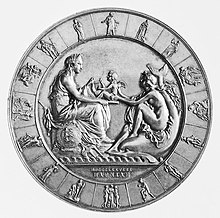| Year | Recipient [2] | Field |
|---|
| 1926 | Karl Jensen | Painter |
| 1927 | Fritz Syberg | Painter |
| 1930 | Carl J. Bonnesen | Sculptor |
| 1932 | Anne Marie Carl-Nielsen | Sculptor |
| 1933 | Niels Larsen Stevns | Painter |
| 1934 | Johan Rohde | Painter |
| 1936 | Niels Hansen Jacobsen | Sculptor |
| 1937 | Niels Skovgaard
Gerhard Henning | Sculptor
Sculptor |
| 1940 | Sigurd Swane
Mogens Bøggild | Painter
Sculptor |
| 1941 | Johannes Larsen
Aksel Jørgensen | Painter
Painter |
| 1942 | Olaf Rude | Painter |
| 1943 | Oluf Høst | Painter |
| 1944 | Einar Utzon-Frank
Johannes C. Bjerg
Hans Knudsen
Svend Hammershøi | Sculptor
Sculptor
Painter
Painter |
| 1946 | Jens Søndergaard
Axel P. Jensen | Painter
Painter |
| 1948 | Rasmus Harboe
Jais Nielsen | Sculptor
Painter |
| 1950 | Jean Gauguin
Adam Fischer | Sculptor
Sculptor |
| 1951 | Ebba Carstensen | Painter |
| 1952 | Elof Risebye
Ole Søndergaard | Painter
Architect |
| 1954 | Astrid Noack | Sculptor |
| 1956 | Laura Brun-Pedersen | Painter |
| 1957 | William Scharff | Painter |
| 1960 | Henrik Starcke | Sculptor |
| 1961 | Erik Hoppe | Painter |
| 1963 | Carl-Henning Pedersen
Palle Nielsen
Axel Poulsen | Painter
Painter
Sculptor |
| 1964 | Georg Jacobsen | Painter |
| 1965 | Niels Lergaard
Jørgen Gudmundsen-Holmgreen | Painter
Sculptor |
| 1966 | Harald Leth
Svend Johansen | Painter
Painter |
| 1967 | Henry Heerup
Lauritz Hartz
Robert Jacobsen | Painter
Painter
Sculptor |
| 1968 | Richard Mortensen
Povl Christensen
Knud Nellemose | Painter
Painter
Sculptor |
| 1969 | Ejler Bille
Paul Gadegaard | Painter
Painter |
| 1970 | Wilhelm Freddie | Painter |
| 1971 | Knud Agger
Peter Alsing Nielsen
Sonja Ferlov Mancoba | Painter
Painter
Sculptor |
| 1972 | Søren Hjorth Nielsen
Erik Thommesen | Painter
Sculptor |
| 1973 | Karl Bovin
Else Alfelt
Willy Ørskov | Painter
Painter
Sculptor |
| 1974 | Søren Georg Jensen | Painter |
| 1975 | Gunnar Westman | Sculptor |
| 1976 | Anna Klindt Sørensen
Gottfred Eickhoff | Painter
Sculptor |
| 1977 | Franciska Clausen
Bent Sørensen | Painter
Sculptor |
| 1978 | Sven Dalsgaard
Ole Schwalbe
Ole Kielberg | Painter
Painter
Painter |
| 1979 | Jørgen Haugen Sørensen
Dan Sterup-Hansen | Sculptor
Painter |
| 1980 | Gunnar Aagaard Andersen | Painter |
| 1983 | Kasper Heiberg | Painter |
| 1984 | Arne Haugen Sørensen
Mogens Andersen
Jane Muus | Painter
Painter
Painter |
| 1985 | Ib Braase | Sculptor |
| 1986 | Frede Christoffersen
Else Fischer-Hansen
Rasmus Nellemann | Painter
Painter
Painter |
| 1987 | Per Kirkeby | Painter |
| 1988 | Albert Mertz | Painter |
| 1989 | Jørn Larsen | Painter |
| 1990 | Christian Daugaard | Painter |
| 1991 | Ib Geertsen | Painter |
| 1982 | Hein Heinsen
Egon Fischer | Sculptor
Sculptor |
| 1994 | Mogens Møller | Sculptor |
| 1995 | Sven Havsteen-Mikkelsen | Painter |
| 1996 | Bjørn Nørgaard | Sculptor |
| 1997 | John Olsen
Richard Winther | Painter
Painter |
| 1998 | Stig Brøgger | Painter |
| 1999 | Torben Ebbesen
Jørgen Boberg | Sculptor
Painter |
| 2000 | Thomas Bang
Kirsten Lockenwitz
Ingálvur av Reyni | Sculptor
Sculptor
Painter |
| 2001 | Ole Sporring | Painter |
| 2002 | Kirsten Ortwed | Sculptor |
| 2003 | Ingvar Cronhammar | Sculptor |
| 2004 | Troels Wörsel | Painter |
| 2005 | Kirsten Justesen
Jytte Rex | Sculptor
Painter |
| 2006 | Jørgen Rømer | Painter |
| 2008 | Erik Hagens | Painter |
| 2009 | Christian Lemmerz | Sculptor |
| 2010 | Morten Stræde
Elisabeth Toubro | Sculptor
Sculptor |
| 2011 | Eva Koch
Freddie A. Lerche | Sculptor
Painter |
| 2012 | Kirsten Klein | Photographer |
| 2013 | Olafur Eliasson
Kirsten Dehlholm | Painter
Painter |
| 2014 | Martin Erik Andersen | Sculptor |
| 2015 | Per Bak Jensen
Viera Collaro | Photographer
Sculptor |
| 2016 | Jesper Christiansen [ da ]
Erik August Frandsen
Jytte Høy | Visual artist
Painter
Visual artist |
| 2017 | Finn Reinbothe | Visual artist [3] |
| 2018 | Lone Høyer Hansen | Sculptor |
| 2019 | Eric Andersen | Visual artist |
| 2020 | Poul Pedersen | Visual artist
|















